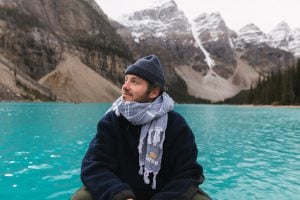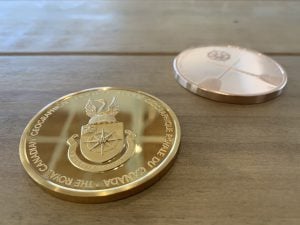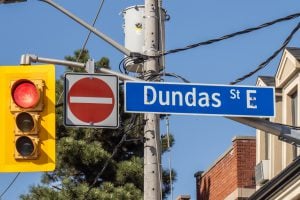
Science & Tech
20 Canadian innovations you should know about
Celebrating Canadian Innovation Week 2023 by spotlighting the people and organizations designing a better future
- 3327 words
- 14 minutes
Travel
On the coast of B.C.'s mainland awaits an immersive experience on the water's edge, where tourism can be an act of reconciliation

Gliding across glassy waters, our small boat follows the curve of a bald eagle’s wing to a rock face where the towering cedar forest meets the sea. The boat slows. Our guide points toward the rock. At first, we don’t see what we’re looking for.
Then, like a story that’s still being written, images start to appear. A flash of dark, reddish brown. Then people in canoes. People dancing. A jellyfish. Prawns. Someone holding a harpoon. Petroglyphs are scattered across the rock, time-worn memories of the coastal First Nations — Klahoose, Tla’amin, Homalco — who once had longhouses here. “This was a checkpoint for all the nations that came here,” says guide Leon Timothy of Tla’amin Nation.
It’s also a reminder: we’re on native land. A bald eagle swoops into view and settles into a tree, eyeing our small group as if to make a point.


We’re here to visit the nearby Klahoose Wilderness Resort, tucked among the twisting inlets of B.C.’s mainland opposite Campbell River on Vancouver Island, owned and operated by the Klahoose First Nation since 2020. The lodge was originally hewn from cedar, just over a decade before it was purchased by Qathen Xwegus Management Corporation, the Klahoose First Nation’s economic development arm. Behind it, only rainforest stretching up a hill to the sky. Cougars prowl. Bears bumble. Trees breathe. It’s off-grid and reachable only by boat from Lund, B.C., a small town plunked at the end of Highway 101, a road that could be said to start more than 15,000 kilometres south in Chile.

After several lives — a wilderness lodge, an eco-resort — the accommodation was relaunched as Klahoose Wilderness Resort in 2021, with a new focus on immersive cultural experiences and outdoor activities such as kayaking, fishing and tours to see grizzly bears and other wildlife. Tourism is a two-way street here, according to Jason Johnson, general manager of the management corporation. Guests have the opportunity to learn from their hosts and enjoy their time in the wilderness, all while directly contributing to the Klahoose First Nation.
“We measure success not simply by profits but by how our businesses have a direct impact on the lives of our people,” says Chief Steven Brown of Klahoose First Nation.
Up a set of stairs from the cold inlet, we’re greeted on the porch of the lodge’s main building by people singing the Klahoose welcome song, composed by Drew Blaney of the Tla’amin Nation. Guide and cultural interpreter Klemkwateki Randy Louie starts on his drum first, joined by guide Leon Timothy, prep cook Riley Harry, head of housekeeping Charissa Hunt, Sofia Nybida, who works in the kitchen, Coral De-lorme from housekeeping and Norman Harry Jr., the resort’s jack-of-all-trades. I feel my foot start to tap, and the tune, if not the words, stays in my head for much of my stay.
After introductions, we’re ushered into what feels like a family room. “Your new home for the next four days ,” says Timothy.

Travel with Can Geo
Experience Klahoose Wilderness Resort
Honouring and celebrating local culture, sustainability, conservation, wildlife, photography and outdoor interests, Klahoose Wilderness Resort offers unique voyages enhanced by knowledgeable RCGS and Can Geo Ambassadors through Canadian Geographic Adventures.
From the windows at the front, “you see the weather comin’ and goin’,” says Timothy: “the wet coast!” Luckily, it’s clear and bright when we arrive, the inlet turquoise and shimmering all the way across to the forested hills opposite the lodge. The dock is now quiet. Seals haul themselves back up to bask, like warm happy slugs, in the sunshine. Inside, there’s a dining table scattered with carving tools, cedar shavings, little wooden paddles and a carved eagle with wings outstretched. “I try to make it look almost realistic yet still Coast Salish,” says Louie of his work. He’s been carving for seven years and is teaching the skill to the younger staff members. “I’m trying to find my own kind of designs,” he says modestly. Louie has an easy smile and a quiet, gentle way of talking. It was Louie who carved the bear that became the logo for the resort.

On the wall to the right of a wood-burning stove hangs a map of the area inked with Klahoose traditional place Oyster River names in ʔayʔaǰuθəm (Ayajuthem), the language spoken by the Homalco, Klahoose, K’omoks and Tla’amin Nations. The map was compiled by treaty researcher Shawn Black, based on interviews with Klahoose Elders. I look at where we are.
The channel that flows past the lodge is called Thíchmyich (“further back inside”), between a point labelled Tuunum (“now unknown”) and a point in what is now known as Forbes Bay called Aap’ukw’um (“having maggots”). Each name holds knowledge for those who can speak the language of this landscape. ƛohos (Klahoose) itself means a sculpin fish.
“For our people, land and language aren’t separate. Our language and culture come from the land; it makes us who we are,” says Chief Brown. “Visitors knowing the traditional place names allows them to better understand our land and culture. For guests to stand on the beach of Toba and be told its traditional name, Yɛkwamɛn, the true home of Klahoose people, is a powerful experience that shifts how they understand the importance of where they are.”
And the next day, when I head to Yɛkwamɛn (Toba Inlet) with Timothy, I understand what the Chief means. Timothy is quick to crack a joke and quicker to read the landscape for signs of wildlife. He’s searching for xawgəs, grizzly bears — a key draw for visitors to Klahoose Wilderness Resort. Xawgəs abound during the late summer and fall salmon run, and when I visit in June, the bears are combing the beaches for mussels, oysters and crabs, and the estuaries for sedges and grasses. The resort is busiest during grizzly season, when guides like Timothy take visitors to Yɛkwamɛn to see the xawgəs up close from viewing platforms set along the river.


The rain is now incessant. A British couple asks Timothy how his people stayed dry before modern rain jackets. “Hide under cedar trees,” he answers with a big grin, chewing gum. “We had great rain jackets back then. Top of the line.”
Timothy peers at the shoreline through a pair of binoculars toward a lump that looks like a rock to the rest of us in the boat. Then, it uncurls its fuzzy limbs, clambers to its feet and lumbers down the beach, patrolling for shellfish. A xawgəs indeed. (“A big boi!” I later type excitedly in my family group chat. It’s my first time seeing a grizzly bear.)
We may be at a comfortable distance from the xawgəs for now, but later that afternoon, after a kayak in the rain, another bear wanders boldly into camp. A mɛxaɬ; a black bear. It munches on grass for a while, before Timothy scares it off in his golf buggy. “Do I have to go?” its expression seems to say, before the bear disappears into the ferns. Do I have to go, too?

The sun sets on the inlet, glowing golden behind dark blue clouds that are heavy with the promise of more rain. Later that night, we will see bio-luminescent algae — a handful of sparkles swept into little eddies by a paddle. It’s our last night at the lodge, and I chat with Louie on the porch. Louie was brought up in Malahat Nation by his mom before moving to Klahoose Nation, where his dad’s family is from.
I ask him how he feels when curious visitors ask him difficult questions, particularly about traumatic events experienced by Indigenous communities. Tourism can be a powerful tool for reconciliation, but I wonder what it means for folks like Louie on the front lines, who are both teaching and learning themselves. Louie explains that he asked permission from the Klahoose Elders to speak about their experiences and that he doesn’t mind talking about the hardships.

He tells me about an uncle, who attended residential school. His uncle used to not talk to anyone about his experiences, but after time, Louie says, he found it helpful to open up. In some ways, Louie says, talking about these things is a way to release the feelings — and to teach that healing to youth.
He smiles when he talks about his attempts to get more people involved in culture nights, even if they’re shy. Culture nights at the lodge involve staff practising drumming and singing, which Louie describes as “medicine” — healing through singing the same songs their ancestors sang. Staff at Klahoose Wilderness Resort aren’t compelled to perform for guests, Louie tells me. Rather, culture nights are an opportunity for staff — and visitors — to learn.
It’s part of a broader strategy of “ensuring our people occupy fulfilling career opportunities and not ‘just a job.’ The Klahoose Wilderness Resort is an essential part of achieving that,” says Chief Brown.
“We are all learning. And this is a process that is never complete,” says Johnson, general manager of Qathen Xwegus Management Corporation, about whether other First Nations can learn from the Indigenous tourism model that Klahoose resort has demonstrated a demand for. But I think Johnson’s sentiment also applies to how tourism can be an act of reconciliation, how we honour the land we’re on and how we can learn from its original peoples.
Klahoose Nation is also using tourism as a tool to get their traditional land back — last year the nation added 14.3 acres (about 5.8 hectares) to Tork Reserve on Cortes Island. “It’s a tool we will continue to utilize, and I would encourage other Nations to as well, but one I wish we didn’t have to,” says Chief Brown. “The 14.3 acres is land that should have been included in our reserve when it was created; however, we had to purchase it back as fee-simple land at market rate. Essentially, we bought our stolen land back and asked Canada’s permission to have it as part of our reserve,” he says.
“Putting the cynicism aside though, this is an exciting opportunity for Klahoose. It’s a 15-minute walk from our community — will create local jobs and allow guests to experience this beautiful place we call home.”

On our final morning, photographer Ben Powless and I decide to go on a hike: a hand-hacked trail through the rainforest to a lookout point.
The forest is reclaiming the path, moss covering footsteps, fallen-over trees obscuring the way. We’re not exactly lost, seeing as we know our way back, but we’re also not exactly sure of the way forwards. And the fact that we heard a cougar was seen in camp a couple weeks back is making us both a little nervous.
We sheepishly call over the radio. Riley Harry, Timothy’s son and the lodge’s prep chef, answers. By happy circumstance, he and his girlfriend are just a bit farther up the trail. He comes back for us, and the trail reveals itself in the presence of someone who knows where they’re going.
From the lookout, we can see the bay and the resort. I sit on a rock and look at the fragments of washed-up sea creatures. A fish jaw, a scale, a piece of bone. Even death seems more alive here. The rocks are slippery, adorned with strands of kelp, wriggling eels and pudgy purple starfish. Turn over a rock, and there’s an ecosystem on the bottom. We head back to camp. This time, we know the way.
Back at the lodge, we gather our things, and the Klahoose family comes to see us off. Louie leads the eagle song from the Lummi Nation. We’ve seen eagle after eagle while we’ve been here, and it seems like an apt farewell.
Before we go, Louie hands me a small hand-carved cedar paddle with a warm smile. I thank him with a lump in my throat.
It’s all waves and hugs. Then we head back toward the inlet’s waves, where cedar forest meets the salty sea
Are you passionate about Canadian geography?
You can support Canadian Geographic in 3 ways:

This story is from the May/June 2023 Issue

Science & Tech
Celebrating Canadian Innovation Week 2023 by spotlighting the people and organizations designing a better future

Travel
Brewed with water and natural ingredients, Corona wants to encourage Canadians to responsibly experience the country’s natural wonders

People & Culture
Award recipients honoured in the first virtual Annual General Meeting and Fellows Show.

People & Culture
The history behind the Dundas name change and how Canadians are reckoning with place name changes across the country — from streets to provinces